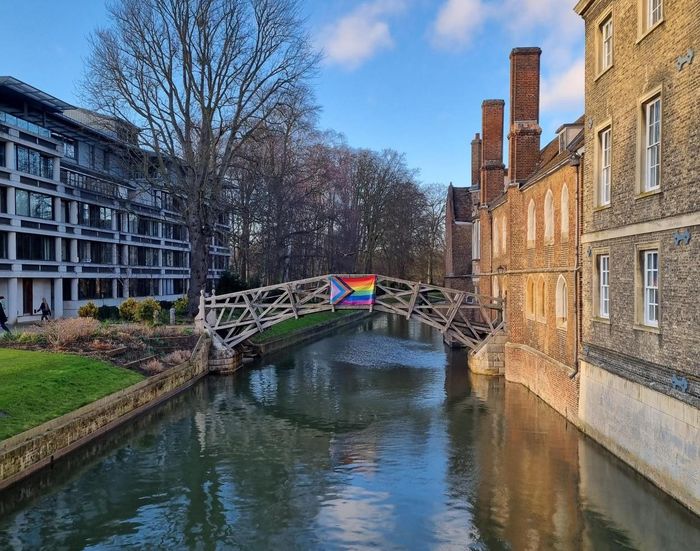‘We’ have always been here
Queer communities have been present at Cambridge for much of its history

As I sat in Trinity Chapel a few weeks ago at the arts night event for LGBTQ+ History Month, I was utterly absorbed by the performances of the many talented queer people who took part. The sentiment, which was beautifully expressed to me in this celebration of history and togetherness, was that ‘we’ are not new, ‘we’ are not foreign, and ‘we’ are part of the narrative of Cambridge. ‘We’, however you’d like to define it, are a part of this place, even if it went unknown and unnoticed, even if our connections were unconventional or erased.
Allow a quick look into Cambridge’s dense history to illustrate this point. Picture, for a moment, the University of the 19th century. Exclusive dining clubs were all the range, private tutors were common, and supervisions casual – maybe it even sounds preferable to 21st century Cambridge. As you struggle through your workload, you can imagine large numbers of white sons of aristocratic families who, protected by their privilege, coasted through. And, perhaps, you may think that a person like yourself, with your background or identity, would’ve never made it to Cambridge if you had been born two hundred years earlier.
“You may think that a person like yourself, with your background or identity, would’ve never made it to Cambridge University”
It’s not an entirely incorrect assumption to make. Oxbridge’s gradual expansion in this century, from landowning and clergy families to the growing public school sector, first allowed upper-middle class boys to invariably go on to Oxbridge. In 1869, Cambridge opened its doors to women, but they were restricted to female-only colleges, and were only allowed to graduate just less than a century later. The stereotypical depiction of a Cambridge student as the affluent, white, heterosexual son, detached from social anxiety, unfortunately rests on the historical reality of this university’s entanglement with discrimination and exclusion. This is a history it continues to grapple with today.
Cambridge students now are keenly aware that the present is a battleground that must be wrenched from the injustices of the past. Much effort is put into moving Cambridge away from the restrictive boxes of this stereotype, which no longer reflects the increasingly diverse demographic of the university today. The increased visibility of students from various class, religious, and ethnic backgrounds, and of differing sexual and gender identities, is integral to the refashioning of what Cambridge intrinsically is. Despite there still being much work to be done, to paint over this history with a ‘white-public school boy’ brush is an injustice to the mosaic of people which today make vital contributions to the life of this University.
Challenging the mysticism and stereotypical presentations of Cambridge today is an important task. At the same time, there has been a neglect of the long history of people and stories that brought us to this very moment. I want to present a case for a similar confrontation with the past. I find it just as much of an injustice to wash over the multitude of lives that have slotted themselves into the Cambridge narrative over the course of centuries, when we brand its history with one ideal type.
“In colleges like King’s, gradually, dislocated spaces of queer community emerged”
There are many angles to look at this from, but for instance, there has always been widespread evidence of same-sex desire at Cambridge. Being gay, of course, did not fit into cultural expectations of the time. However, as Simon Goldhill’s book Queer Cambridge powerfully details, in colleges like King’s, dislocated spaces of queer community gradually emerged, hinged on intergenerational interaction and networks of students and teachers. Cross-dressing was very popular in student societies, in both male and female colleges in the second half of the 19th century, including extravagant plays and ‘mock trials’ where actors would knowingly merge parody with flirtation. Cross-dressing provided opportunities for queer play with gender, and was part of the homosocial texture of University life. Same-sex desire and queer stories were navigated but also embedded within the predominantly masculine environment of Cambridge, in both its culture and history.
I strongly encourage anyone who’s interested in the diversity of people who have slotted themselves into Cambridge history to look even further into these stories. Of the thousands of names that have signed matriculation books across centuries, some of them are prominently known, like those of Alan Turing, E. M. Forster, and John Maynard Keynes. But, the purpose of this exploration is to pay homage to the names which aren’t seen. Despite the imposing cultural barriers of this place, ‘we’ have always been here. I believe this can move us away from purely seeing this history as one of struggle to get here, and that instead, it has also been a battle to be seen here.
Cambridge’s history is not just a parade of prime ministers, but a centuries-old accumulation of the joy, resilience, and effort of students, teachers, performers, workers, and intellectuals. Reforming stereotypical depictions of the University’s past is just as important as reforming the stereotypes of its present.
Want to share your thoughts on this article? Send us a letter to letters@varsity.co.uk or by using this form.
 Comment / Cambridge’s tourism risks commodifying students18 April 2025
Comment / Cambridge’s tourism risks commodifying students18 April 2025 News / Cambridge student numbers fall amid nationwide decline14 April 2025
News / Cambridge student numbers fall amid nationwide decline14 April 2025 News / Greenwich House occupiers miss deadline to respond to University legal action15 April 2025
News / Greenwich House occupiers miss deadline to respond to University legal action15 April 2025 Comment / The Cambridge workload prioritises quantity over quality 16 April 2025
Comment / The Cambridge workload prioritises quantity over quality 16 April 2025 Sport / Cambridge celebrate clean sweep at Boat Race 202514 April 2025
Sport / Cambridge celebrate clean sweep at Boat Race 202514 April 2025





